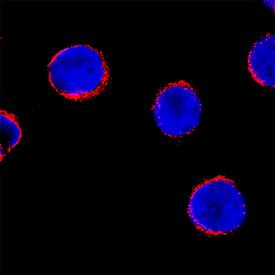Human BAK Antibody
R&D Systems, part of Bio-Techne | Catalog # MAB8161

Key Product Details
Species Reactivity
Human
Applications
Immunocytochemistry, Western Blot
Label
Unconjugated
Antibody Source
Monoclonal Mouse IgG1 Clone # 564305
Product Specifications
Immunogen
E. coli-derived recombinant human BAK
Pro20-Asn124
Accession # Q16611
Pro20-Asn124
Accession # Q16611
Specificity
Detects endogenous human BAK in Western blots.
Clonality
Monoclonal
Host
Mouse
Isotype
IgG1
Scientific Data Images for Human BAK Antibody
Detection of Human BAK by Western Blot.
Western blot shows lysates of Jurkat human acute T cell leukemia cell line, 293T human embryonic kidney epithelial cell line, and Daudi human Burkitt's lymphoma cell line. PVDF membrane was probed with 1 µg/mL of Mouse Anti-Human BAK Monoclonal Antibody (Catalog # MAB8161) followed by HRP-conjugated Anti-Mouse IgG Secondary Antibody (Catalog # HAF007). A specific band was detected for BAK at approximately 23 kDa (as indicated). This experiment was conducted under reducing conditions and using Immunoblot Buffer Group 2.BAK in Jurkat Human Cell Line.
BAK was detected in immersion fixed Jurkat human acute T cell leukemia cell line using Mouse Anti-Human BAK Monoclonal Antibody (Catalog # MAB8161) at 8 µg/mL for 3 hours at room temperature. Cells were stained using the NorthernLights™ 557-conjugated Anti-Mouse IgG Secondary Antibody (red; Catalog # NL007) and counterstained with DAPI (blue). Specific staining was localized to cytoplasm. View our protocol for Fluorescent ICC Staining of Cells on Coverslips.Applications for Human BAK Antibody
Application
Recommended Usage
Immunocytochemistry
5-25 µg/mL
Sample: Immersion fixed Jurkat human acute T cell leukemia cell line
Sample: Immersion fixed Jurkat human acute T cell leukemia cell line
Western Blot
1 µg/mL
Sample: Jurkat human acute T cell leukemia cell line, 293T human embryonic kidney epithelial cell line, and Daudi human Burkitt's lymphoma cell line
Sample: Jurkat human acute T cell leukemia cell line, 293T human embryonic kidney epithelial cell line, and Daudi human Burkitt's lymphoma cell line
Reviewed Applications
Read 1 review rated 4 using MAB8161 in the following applications:
Formulation, Preparation, and Storage
Purification
Protein A or G purified from hybridoma culture supernatant
Reconstitution
Reconstitute at 0.5 mg/mL in sterile PBS. For liquid material, refer to CoA for concentration.
Formulation
Lyophilized from a 0.2 μm filtered solution in PBS with Trehalose. *Small pack size (SP) is supplied either lyophilized or as a 0.2 µm filtered solution in PBS.
Shipping
Lyophilized product is shipped at ambient temperature. Liquid small pack size (-SP) is shipped with polar packs. Upon receipt, store immediately at the temperature recommended below.
Stability & Storage
Use a manual defrost freezer and avoid repeated freeze-thaw cycles.
- 12 months from date of receipt, -20 to -70 °C as supplied.
- 1 month, 2 to 8 °C under sterile conditions after reconstitution.
- 6 months, -20 to -70 °C under sterile conditions after reconstitution.
Background: BAK
Long Name
Bcl-2 Antagonist/Killer
Alternate Names
BAK1, BCL2L7
Gene Symbol
BAK1
UniProt
Additional BAK Products
Product Documents for Human BAK Antibody
Product Specific Notices for Human BAK Antibody
For research use only
